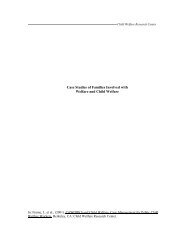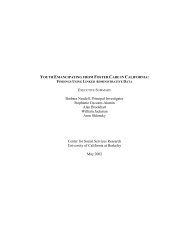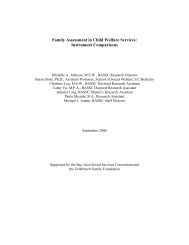Developing a Self-Assessment Toolfor Culturally - Office of Minority ...
Developing a Self-Assessment Toolfor Culturally - Office of Minority ...
Developing a Self-Assessment Toolfor Culturally - Office of Minority ...
You also want an ePaper? Increase the reach of your titles
YUMPU automatically turns print PDFs into web optimized ePapers that Google loves.
numerous promising CLAS practices are reported as examples <strong>of</strong> ways organizations areproviding health care services to better serve their increasingly diverse service populations.Use self-assessment tool in quality improvement efforts. Use <strong>of</strong> the instrumentscould assist LPHAs in effectively monitoring and improving services for culturally andlinguistically diverse groups. The three-component self-assessment tool could be used inits entirety, or may be customized or expanded to meet particular monitoring needs. Forinstance, the tool may be especially useful to agencies that want to expand theirmanagement information systems to more closely and carefully monitor health care qualityfor culturally and linguistically diverse clients.Conduct domain-specific organizational assessments. LPHAs may want to monitorCLAS quality in a particular area by focusing on a single domain or multiple domains.These studies would allow for separate, in-depth investigations to more thoroughlydescribe practices within individual domains, e.g., CLAS plans and policies (Domain 2),staff diversity training (Domain 7), or communication support (Domain 8).Explore consumer and health care provider perspectives. The self-assessment tooldeveloped for this project was designed to collect data that represent the organizationalside <strong>of</strong> CLAS provision. However, equally interesting and important are data thatrepresent the patient/consumer side <strong>of</strong> CLAS provision. Research that fully accounts forthe perceptions and experiences <strong>of</strong> culturally and linguistically diverse LPHA clients whodepend on and utilize CLAS could provide decision-makers with key insights to theeffectiveness <strong>of</strong> various types <strong>of</strong> CLAS. Similarly, understanding the perspectives andexperiences <strong>of</strong> physicians and other staff would be valuable. Clinical and non-clinical staffare responsible for the delivery <strong>of</strong> services. Inquiries with this population also could shedlight on the benefits and challenges associated with providing CLAS, based on real-worldexperiences delivering services to culturally and linguistically diverse clients.Update the CLAS conceptual framework to include measures that account for newpractices and technologies. Since the start <strong>of</strong> the CLAS in MCOs study, new CLASrelatedstrategies and services have been developed and even tested and publicized byhealth care entities across the country, such as videoconferencing interpretation systemsand other translation devices for patients who need translation services. Therefore, theframework should be periodically revisited—especially at the key element and variablelevels—in an effort to ensure that the framework is representative <strong>of</strong> current CLASmeasures and to continually improve the comprehensiveness <strong>of</strong> measures.Conduct state or national organizational assessments. Although the present projectwas to develop a self-assessment tool for LPHAs, organizations that are interested incollecting data from LPHAs in a specific state or from a nationally representative sample<strong>of</strong> LPHAs can use the self-assessment tool along with the data collection plan developedfor the CLAS in MCOs study. For this purpose, Appendix G includes a description <strong>of</strong> theCOSMOS Corporation, December 2003 3-4
















